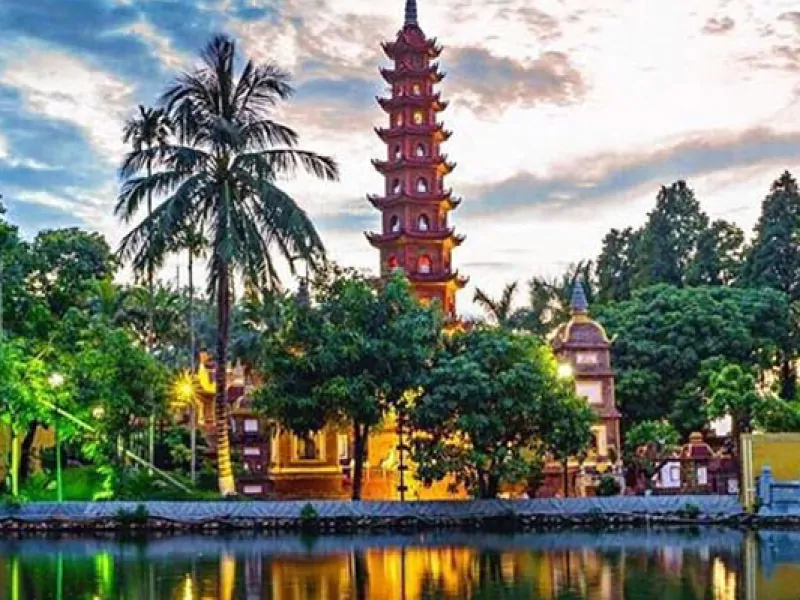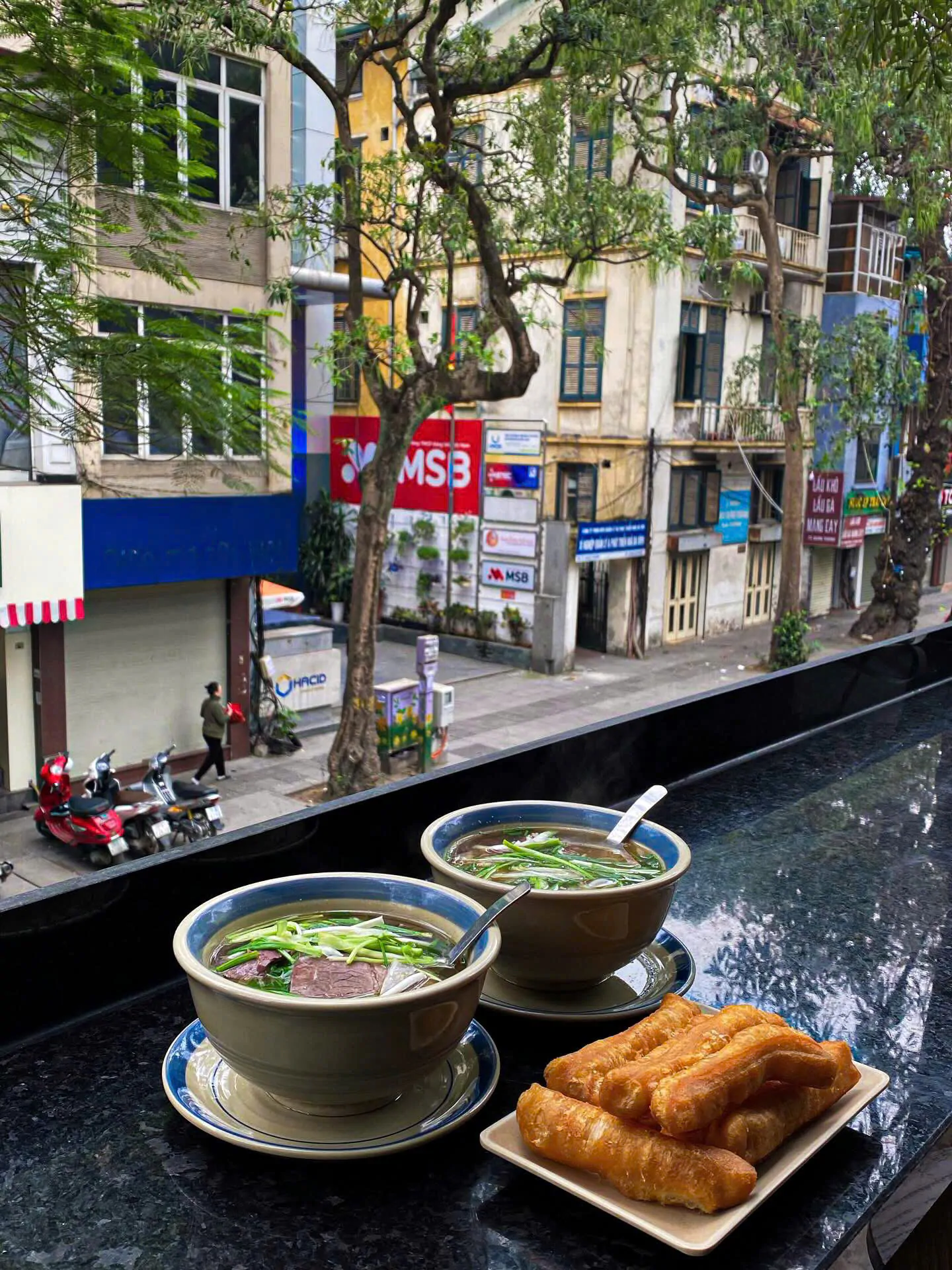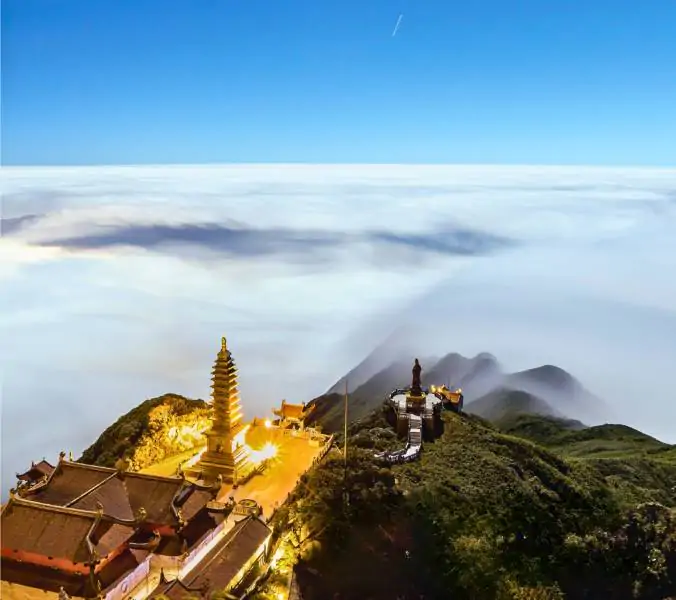Contents
Hanoi has long been a captivating destination for Buddhist followers, home to many revered ancient temples, especially around West Lake. Among them, Tran Quoc Pagoda stands out as the oldest and most iconic, making it a must-visit for those interested in Buddhism. With a history spanning over 1,500 years, this venerable pagoda has played a crucial role in the cultural and spiritual development of Vietnam, drawing countless visitors from around the globe annually. If you’re planning a trip with Vietnam Discovery Travel, be sure to include Tran Quoc Pagoda on your itinerary for an unforgettable experience.
1. History Of Tran Quoc Pagoda
Location: Thanh Nien Street, Yen Phu Ward, Tay Ho District, Hanoi
Opening Hours: from 8:00 AM to 4:00 PM daily
Admission Fee: Free
Dress Code: Shorts, short skirts, and sleeveless shirts are not allowed.
Map to Tran Quoc Pagoda.
Tran Quoc Pagoda has a rich history dating back to its construction in 541 and completion in 545 during the reign of King Ly Nam De. At that time, the pagoda was known as Khai Quoc Pagoda (Khai Quoc meaning “National Founder”). It was initially built on the banks of the Red River. However, after over 150 years, when the riverbank collapsed, it was relocated to Kim Ngư Islet in the early 17th century, under the reign of King Le Kinh Tong. Since then, it was renamed Tran Quoc Pagoda (Tran meaning “Defending” and Quoc meaning “Country”).

With a history spanning over a thousand years, Tran Quoc Pagoda was once the capital of Buddhism during the Tran dynasty and is now regarded as an iconic symbol of the capital city of Hanoi, representing both its past and present.
2. Architecture and Structure:
Tran Quoc Pagoda is renowned for its profound cultural and Buddhist values. Famous for its sacred site and stunning scenery, Tran Quoc Pagoda has been a favorite destination for many Vietnamese kings during special festivals such as Tet and full moon days. Despite urbanization, over 1000 years have passed, yet the pagoda still maintains its reputation and unique architectural features.

Thanks to its convenient location right next to the resplendent West Lake and on an island connected by a bridge between two of Hanoi’s most picturesque lakes, Truc Bach Lake and West Lake, the pagoda attracts a large number of tourists every day.
Tran Quoc boasts a distinctive architecture similar to ancient temples in Hanoi. It exudes the imagery of Buddhist architecture with multiple layers of structures. This can be observed prominently through the three main houses of the pagoda. Why are there three main houses? Because Vietnamese people believe that the number three symbolizes luck and prosperity.

Its entrance is a unique feature of the pagoda. From a distance, the gate seems slanted, but as you approach, you don’t feel any sense of it.
Upon passing through the gate, you need to follow the path paved with red bricks to catch a glimpse of the inner space.
The Front Hall (Ante-chamber) is situated in front of the bell tower and faces west. In front of the front hall, there is an incense burner in the courtyard for Buddhists and visitors to light incense.
The Ancestors’ House is located to the right of the Front Hall, where the previous generations of monks are worshiped.
The Stele House is situated to the left of the Front Hall, preserving 14 important steles engraved from 1813 to 1815. It illustrates the process of renovating the temple after a long period of neglect.
The three main houses are connected to each other, creating a resemblance to a blooming lotus flower. It can be said that Tran Quoc Pagoda is a harmonious combination of the serene scenery of lush greenery, a distant lake, and ancient, majestic architecture. That’s why it was recognized by the Ministry of Culture and Information as a national cultural and historical relic in 1962.

3. Highlights of Tran Quoc Pagoda:
Passing through the garden, visitors have the opportunity to see the sacred Bodhi tree with heart-shaped leaves. The tree was gifted to the pagoda in 1959 by Indian President Rajendra Prasad. Many believe it to be a branch of the sacred Bodhi tree where the Buddha attained enlightenment. That’s why tourists and pilgrims come here to honor this relic from all over the world.

In addition, a fairly complete system of statues is still preserved at Tran Quoc Pagoda. It can be said that Tran Quoc is a small museum preserving priceless artifacts. Most of them date back hundreds of years, such as some statues worshiped in the front hall. Especially notable in the pagoda are the statues of the Three Saints and various ancestral masters. The most prominent is the statue of the reclining Buddha (commonly referred to as the reclining Buddha, or in Vietnamese, Thích Ca Thập Niết Bản). Such statues are rare in the North but are predominantly found in Thailand or Laos. And this particular statue is regarded as the most beautiful statue in Vietnam.
Due to its beautiful and tranquil scenery, Tran Quoc Pagoda is mentioned in many poems, couplets, and writings by Vietnamese monarchs and officials, especially during the Nguyen Dynasty. Even today, many poems are still preserved within the pagoda. You will have the opportunity to explore the ancient Vietnamese literary style as well as the history of the country.
It would be remiss not to mention the Bảo Tháp Lục Đồ Đại Sen (Sixteen-story Great Lotus Stupa). It is an eleven-story building standing at 15 meters tall. Built in 1998, it has six vaulted doorways and a statue on each floor. The statues resemble the Buddha Amitabha and are made of precious stones. At the top of the stupa is a nine-story lotus tower called the Cửu Phạm Liên Hoan (Nine-stacked Lotuses in Full Bloom).
4. Getting to Tran Quoc Pagoda
The pagoda is only 5 km from the city center, so you can reach it by various means of transportation.
By bus: You can take bus number 50 directly to the pagoda’s entrance. If this bus is not convenient, you can take bus number 31, 41, 55A, 55B, or 58 to An Dương bus station, then walk about 5 minutes to the pagoda.
By taxi: To reach the pagoda by taxi, it’s advisable to book a taxi through the Grab app on your mobile phone.
By motorbike or scooter: You can rent a motorbike for easier mobility around West Lake as well. It takes about 12 minutes to reach the pagoda.
5. Tips for Visiting Tran Quoc Pagoda:
The pagoda is always crowded, especially on the 1st and 15th days of the lunar month, when Buddhist monks and tourists come to visit the pagoda for worship and sightseeing. If you want to explore the religious culture of the Vietnamese people, these two days are always a great time. But if you don’t like large crowds, it’s best to avoid these days.
As the pagoda is a sacred place, visitors must dress appropriately according to the prescribed dress code. Remember to wear suitable clothing and avoid revealing attire.
Just like when entering any temple around the world, remember to remove hats, umbrellas, and shoes before entering the places of worship. It shows your respect for the deities and the temples.
Vietnam is definitely a must-visit destination for those passionate about spiritual tourism. If you have the opportunity to set foot in this beautiful country, don’t miss the chance to visit Tran Quoc Pagoda – the oldest pagoda in Northern Vietnam.
When planning a trip to Tran Quoc Pagoda in Hanoi, aside from Tran Quoc Pagoda, you should consider visiting other fantastic destinations such as:
Presidential Palace, Turtle Tower, Ngoc Son Temple, Ba Dinh Square, Bach Ma Temple, But Thap Pagoda, Temple of Literature Hanoi, etc.. These places offer diverse experiences, ranging from pristine beaches and bustling cities to charming historical sites and enchanting landscapes.
6. Conclusion
To ensure the best vacation experience in Vietnam, it’s important to plan and book in advance. Among the many tour companies offering services in Vietnam, Discover Vietnam Tours is a great option for arranging your travel itinerary with just a few emails and WhatsApp messages. They provide airport transfers, accommodation booking, tour guides, drivers, and customizable activities based on your preferences.
With their assistance, you can tailor your trip according to your desired schedule and preferences, ensuring a seamless and enjoyable travel experience throughout Vietnam.






















